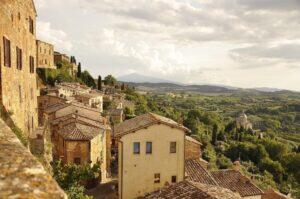Fodor's Expert Review Duomo
Siena's cathedral is one of the finest Gothic churches in Italy. The multicolored marble and painted decoration are typical of the Italian approach to Gothic architecture—lighter and much less austere than the French. The amazingly detailed facade has few rivals. It was completed in two brief phases at the end of the 13th and 14th centuries. The statues and decorative work were designed by Nicola Pisano and his son Giovanni, although much of what's seen today are copies, the originals having been removed to the adjacent Museo dell'Opera Metropolitana. The gold mosaics are 18th-century restorations. The campanile (no entry) is among central Italy's finest, the number of windows increasing with each level, a beautiful and ingenious way of reducing the weight of the structure as it climbs to the heavens.
With its dark-green-and-white striping throughout and its illusionistic coffered and gilded dome, the Duomo's interior is simply striking. Look up at copies of Duccio's (circa... READ MORE
Siena's cathedral is one of the finest Gothic churches in Italy. The multicolored marble and painted decoration are typical of the Italian approach to Gothic architecture—lighter and much less austere than the French. The amazingly detailed facade has few rivals. It was completed in two brief phases at the end of the 13th and 14th centuries. The statues and decorative work were designed by Nicola Pisano and his son Giovanni, although much of what's seen today are copies, the originals having been removed to the adjacent Museo dell'Opera Metropolitana. The gold mosaics are 18th-century restorations. The campanile (no entry) is among central Italy's finest, the number of windows increasing with each level, a beautiful and ingenious way of reducing the weight of the structure as it climbs to the heavens.
With its dark-green-and-white striping throughout and its illusionistic coffered and gilded dome, the Duomo's interior is simply striking. Look up at copies of Duccio's (circa 1255–1319) stained-glass panels; the originals, finished in 1288, are in the Museo dell'Opera and are among the oldest examples of stained glass in Italy. The Duomo is most famous, though, for its inlaid-marble floors, which took almost 200 years to complete. More than 40 artists contributed to the magnificent work of 56 compositions depicting biblical scenes, allegories, religious symbols, and civic emblems. Although conserving the floors requires keeping them covered for much of the year, they are unveiled from the end of June until the end of July and from mid-August until mid-October.
Also noteworthy is the Duomo's carousel pulpit, carved by Nicola Pisano around 1265; the Life of Christ is depicted on the rostrum frieze. In striking contrast to the nave's Gothic decoration are the well-preserved Renaissance frescoes in the Biblioteca Piccolomini, off the left aisle. Painted by Pinturicchio (circa 1454–1513) and completed in 1509, they depict events from the life of Aeneas Sylvius Piccolomini (1405–64), who became Pope Pius II in 1458.
The Duomo is grand, but the medieval Sienese people had even grander plans, namely, to use the existing church as a transept and build a new nave running toward the southeast, creating what would have been the world's largest church. Alas, only the side wall and part of the new facade were completed when the Black Death struck in 1348. The city subsequently fell into decline, funds dried up, and the plans were never carried out.
Indeed, the grand church project was actually doomed from the start—subsequent attempts to get it going revealed that the foundation was insufficient to bear the weight of the proposed structure. In any event, the unfinished new nave extending from the right side of the Duomo was ultimately enclosed to house the Museo dell'Opera. The Cripta was discovered during routine preservation work on the church.
READ LESS





